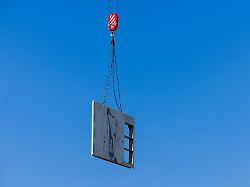Controversy over new forecast
Does Germany lack a lot less housing than expected?
By Max Bourne
March 13, 2024, 6:10 p.m
According to a new forecast, the need for new construction per year is several hundred thousand apartments below the targets set by the government, associations and industry representatives. The study authors face criticism. They are by no means setting the bar low for housing policy.
Germany urgently needs more housing. That is consensus. For many years now, fewer houses have been built than are needed. But how many apartments are missing exactly? 400,000 per year, as the federal government has set itself as a new building target? 800,000 or even more, as some associations and lobby groups claim? In this chorus of large numbers, the private research institute Empirica, which specializes in the real estate market, is causing a stir with a study. The experts forecast a need for just 170,000 new apartments in Germany in the coming years. However, they would also have to be built where they were really needed. A significant proportion of new apartments are currently being built “in the wrong place” and are not helping to alleviate the housing shortage.
In its current housing market forecast Based on the demographic development in all German districts and cities, Empirica estimates the need for additional apartments by 2045. In a medium scenario for population development, the institute assumes that 170,000 apartments would be needed annually in Germany in this and the next three years from 2028 to 2032 only 160,000 per year and that from the mid-2030s onwards the need for new cash will increase slightly again. If the population increases or decreases more rapidly, the need for construction will be correspondingly higher or lower.
With these figures, Empirica received heavy criticism. Among others, the head of Germany’s largest housing group Vonovia, Rolf Buch, reacted incomprehensibly in a LinkedIn post. The experts should take a look at the queue at a viewing appointment for a Vonovia apartment in order to “compare their headline-grabbing report with reality”. According to Buch, the housing crisis is one of the biggest social problems of our time and should not be “played down”.
“Nothing is further from us than downplaying the housing shortage,” replies Empirica boss Reiner Braun in an interview with ntv.de. His institute’s forecast should by no means be understood as an all-clear. The aim is to differentiate, i.e. to show which regions have a need for new construction and which do not due to the expected decline in population.
“Success must be measured locally”
The forecast shows that there will be a need for new single- and two-family homes in the coming years, especially in the northwest and south of Germany and in the Berlin area. The demand for new construction of multi-story apartments exists almost exclusively in large cities. Meeting the need for new housing in these cities and counties is a challenge, even if it is “only” 170,000 per year. In the metropolises, where the shortage is greatest, the hurdles for new construction are particularly high, especially because of the lack of building land.
Therefore, says Braun, it is important not to base new housing construction on large, global figures. “The success of housing policy must be measured locally.” Even if 400,000 apartments or more were actually built in Germany in a year, that still says nothing about whether the housing shortage in the big cities has been reduced. Experience has shown that many new houses are being built where there are already enough apartments. It is understandable that young families are building a new, comfortable house in a shrinking rural region. “If this keeps young people in such regions, that’s positive,” says Braun. “However, this new building does not contribute quantitatively to solving the housing shortage in the cities.” In 2022, 115,000 apartments, almost 40 percent of the completions that year, were built “in the wrong place,” according to the Empirica study.
The target of 170,000 new apartments calculated by Empirica is well below the federal government’s self-imposed target of 400,000 completions annually, but it will still be difficult to achieve in the coming years. Housing construction is currently experiencing a sharp decline due to increased interest rates. The IFO Institute, for example, expects only 225,000 completions this year. After that, the number is likely to fall further. Assuming that a similar proportion of new housing construction as in the past will not take place where it is needed, there is unlikely to be enough left in the “right place” to stabilize the strained housing markets.
